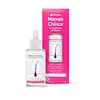What's inside
What's inside
 Key Ingredients
Key Ingredients

No key ingredients
 Benefits
Benefits

 Concerns
Concerns

 Ingredients Side-by-side
Ingredients Side-by-side

Water
Skin ConditioningCetearyl Alcohol
EmollientGlycerin
HumectantBehentrimonium Chloride
PreservativeCocos Nucifera Oil
MaskingPEG-40 Hydrogenated Castor Oil
EmulsifyingGuar Hydroxypropyltrimonium Chloride
Skin ConditioningSalvia Officinalis Oil
MaskingMentha Piperita Oil
MaskingEucalyptus Globulus Leaf Oil
PerfumingRosmarinus Officinalis Stem Oil
PerfumingHydrolyzed Rice Protein
Skin ConditioningOrbignya Oleifera Seed Oil
EmollientMethyl Gluceth-10
EmulsifyingVitis Vinifera Seed Oil
EmollientCetrimonium Chloride
AntimicrobialStearalkonium Chloride
PreservativePhenyl Trimethicone
Skin ConditioningHydroxypropylammonium Gluconate
HumectantHydroxypropylgluconamide
HumectantPropylene Glycol
HumectantQuaternium-80
Althaea Officinalis Root Extract
Skin ConditioningBiotin
AntiseborrhoeicMenthol
MaskingIsopropyl Alcohol
SolventBis-Aminopropyl Dimethicone
Cyclopentasiloxane
EmollientPhenoxyethanol
PreservativeEthylhexylglycerin
Skin ConditioningBenzyl Benzoate
AntimicrobialPEG-90m
Emulsion StabilisingParfum
MaskingCoumarin
PerfumingLimonene
PerfumingLinalool
PerfumingWater, Cetearyl Alcohol, Glycerin, Behentrimonium Chloride, Cocos Nucifera Oil, PEG-40 Hydrogenated Castor Oil, Guar Hydroxypropyltrimonium Chloride, Salvia Officinalis Oil, Mentha Piperita Oil, Eucalyptus Globulus Leaf Oil, Rosmarinus Officinalis Stem Oil, Hydrolyzed Rice Protein, Orbignya Oleifera Seed Oil, Methyl Gluceth-10, Vitis Vinifera Seed Oil, Cetrimonium Chloride, Stearalkonium Chloride, Phenyl Trimethicone, Hydroxypropylammonium Gluconate, Hydroxypropylgluconamide, Propylene Glycol, Quaternium-80, Althaea Officinalis Root Extract, Biotin, Menthol, Isopropyl Alcohol, Bis-Aminopropyl Dimethicone, Cyclopentasiloxane, Phenoxyethanol, Ethylhexylglycerin, Benzyl Benzoate, PEG-90m, Parfum, Coumarin, Limonene, Linalool
Water
Skin ConditioningButylene Glycol
HumectantPropanediol
SolventGlycerin
HumectantPEG-40 Hydrogenated Castor Oil
Emulsifying1,2-Hexanediol
Skin ConditioningActinidia Chinensis Fruit Extract
EmollientPanthenol
Skin ConditioningAleurites Moluccanus Seed Extract
Skin ConditioningPolyacrylate Crosspolymer-6
Emulsion StabilisingPropylene Glycol
HumectantCaprylhydroxamic Acid
Parfum
MaskingTocopheryl Acetate
AntioxidantPisum Sativum Peptide
Skin ConditioningT-Butyl Alcohol
PerfumingWater, Butylene Glycol, Propanediol, Glycerin, PEG-40 Hydrogenated Castor Oil, 1,2-Hexanediol, Actinidia Chinensis Fruit Extract, Panthenol, Aleurites Moluccanus Seed Extract, Polyacrylate Crosspolymer-6, Propylene Glycol, Caprylhydroxamic Acid, Parfum, Tocopheryl Acetate, Pisum Sativum Peptide, T-Butyl Alcohol
 Reviews
Reviews

Ingredients Explained
These ingredients are found in both products.
Ingredients higher up in an ingredient list are typically present in a larger amount.
Glycerin is already naturally found in your skin. It helps moisturize and protect your skin.
A study from 2016 found glycerin to be more effective as a humectant than AHAs and hyaluronic acid.
As a humectant, it helps the skin stay hydrated by pulling moisture to your skin. The low molecular weight of glycerin allows it to pull moisture into the deeper layers of your skin.
Hydrated skin improves your skin barrier; Your skin barrier helps protect against irritants and bacteria.
Glycerin has also been found to have antimicrobial and antiviral properties. Due to these properties, glycerin is often used in wound and burn treatments.
In cosmetics, glycerin is usually derived from plants such as soybean or palm. However, it can also be sourced from animals, such as tallow or animal fat.
This ingredient is organic, colorless, odorless, and non-toxic.
Glycerin is the name for this ingredient in American English. British English uses Glycerol/Glycerine.
Learn more about GlycerinParfum is a catch-all term for an ingredient or more that is used to give a scent to products.
Also called "fragrance", this ingredient can be a blend of hundreds of chemicals or plant oils. This means every product with "fragrance" or "parfum" in the ingredients list is a different mixture.
For instance, Habanolide is a proprietary trade name for a specific aroma chemical. When used as a fragrance ingredient in cosmetics, most aroma chemicals fall under the broad labeling category of “FRAGRANCE” or “PARFUM” according to EU and US regulations.
The term 'parfum' or 'fragrance' is not regulated in many countries. In many cases, it is up to the brand to define this term.
For instance, many brands choose to label themselves as "fragrance-free" because they are not using synthetic fragrances. However, their products may still contain ingredients such as essential oils that are considered a fragrance by INCI standards.
One example is Calendula flower extract. Calendula is an essential oil that still imparts a scent or 'fragrance'.
Depending on the blend, the ingredients in the mixture can cause allergies and sensitivities on the skin. Some ingredients that are known EU allergens include linalool and citronellol.
Parfum can also be used to mask or cover an unpleasant scent.
The bottom line is: not all fragrances/parfum/ingredients are created equally. If you are worried about fragrances, we recommend taking a closer look at an ingredient. And of course, we always recommend speaking with a professional.
Learn more about ParfumPeg-40 Hydrogenated Castor Oil is derived from castor oil and polyethylene glycol (PEG). It is used as a emollient and emulsifier.
As an emulsifier, it helps prevent ingredients from separating. It also helps make the other ingredients more soluble; it is often used to solubilize fragrances. This increases spreadability and elongates shelf life in a product.
Emollients help soothe and soften the skin. They do this by creating a protective film on your skin. This barrier helps trap moisture and keeps your skin hydrated. Emollients may be effective at treating dry or itchy skin.
This ingredient may or may not be vegan, depending on the source.
Peg-40 Hydrogenated Castor Oil may not be fungal-acne safe. We recommend speaking with a professional if you have any questions or concerns.
Learn more about PEG-40 Hydrogenated Castor OilPropylene Glycol is an odorless, colorless liquid. As a humectant, it helps skin retain moisture. It also aids in delivering active ingredients.
Another role of this ingredient is preventing a product from melting or freezing. Propylene glycol also adds antimicrobrial properties to a product, elongating product lifespan.
This ingredient is considered an organic alcohol and commonly added into both cosmetics and foods.
Those with sensitive skin or conditions may develop a rash when using this ingredient.
Learn more about Propylene GlycolWater. It's the most common cosmetic ingredient of all. You'll usually see it at the top of ingredient lists, meaning that it makes up the largest part of the product.
So why is it so popular? Water most often acts as a solvent - this means that it helps dissolve other ingredients into the formulation.
You'll also recognize water as that liquid we all need to stay alive. If you see this, drink a glass of water. Stay hydrated!
Learn more about Water